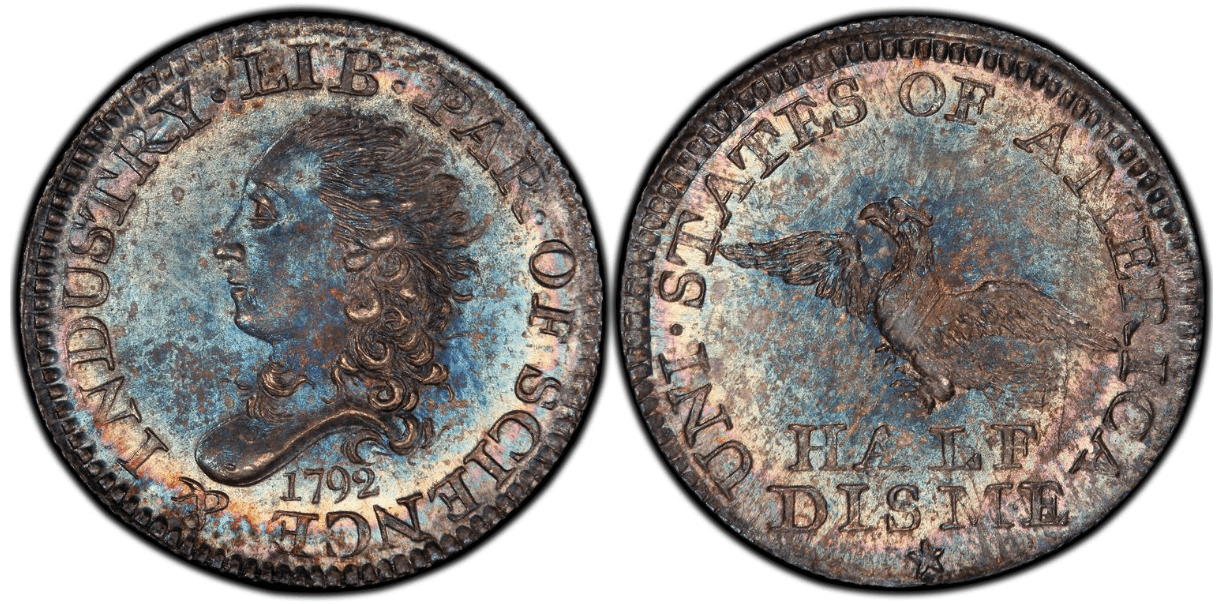The half dime, a small silver coin valued at five cents, holds a significant place in American coinage, mirroring the young nation's economic and artistic development. Among the various iterations of the half dime, the Bust Half Dime and the Seated Liberty Half Dime stand out for their historical importance and numismatic appeal. These coins not only served as crucial denominations in everyday transactions but also showcased the evolving artistry of the United States Mint.

Image source: PCGS
Bust Half Dime History
The Bust Half Dime, minted from 1794 to 1837, represents one of the earliest coinage designs of the United States. This category is further divided into two main designs: the Draped Bust (1796-1805) and the Capped Bust (1829-1837). The initial design, known as the Flowing Hair type, was short-lived and quickly replaced by the Draped Bust design, which featured Lady Liberty with flowing hair and a draped bust on the obverse, and an eagle on the reverse. In 1829, the Mint introduced the Capped Bust design, which depicted Liberty wearing a cap and featured a more detailed and refined portrayal. This period marked significant improvements in minting technology and artistic detailing, reflecting the United States' growing sophistication in coin design.
Seated Liberty Half Dime History
Following the Bust series, the Seated Liberty Half Dime emerged, with production spanning from 1837 to 1873. This design introduced a new emblem of American liberty: a seated figure of Liberty, holding a staff and cap, an image inspired by Britannia and other classical figures representing national identity. The Seated Liberty design underwent several minor modifications over its lifespan, including the addition and removal of stars around the obverse perimeter and modifications to the reverse design, which generally featured a wreath and the denomination. The Seated Liberty Half Dime reflects a period of significant growth and change in the United States, including westward expansion and the tumultuous years surrounding the Civil War.
FAQ
What is a half dime?
A half dime is a silver coin valued at five cents, originally minted in the United States from 1794 to 1873. It predates the nickel by several decades and was part of the early U.S. coinage system.
When was the first half dime minted?
The first half dime was officially minted in 1794, although there are records of pattern pieces known as the 1792 half disme, which were likely produced as trial pieces.
What does "disme" mean in the context of half dimes?
"Disme" (pronounced "deem") is an early spelling of "dime" and refers to one-tenth of a dollar. The term was used in the original legislation that established the U.S. Mint and its coinage.
Who designed the first half dimes?
Robert Scot, the first Chief Engraver of the U.S. Mint, is credited with designing the early half dimes, including the Flowing Hair and Draped Bust series.
Why were half dimes made of silver?
Silver was chosen for half dimes to align with the bimetallic standard of the time, which used both gold and silver as the basis for the U.S. currency, ensuring the coin's value was intrinsic to its metal content.
What are the different types of half dimes?
The main types include the Flowing Hair (1794-1795), Draped Bust (1796-1805), Capped Bust (1829-1837), Seated Liberty without stars (1837-1838), Seated Liberty with stars (1838-1859), and Seated Liberty with legend (1860-1873).
How much did half dimes weigh?
The weight of half dimes varied slightly over the years but was generally around 1.34 grams, with a composition of 89.24% silver and 10.76% copper.
What is the significance of the 1792 half disme?
The 1792 half disme is considered one of the first coins struck by the newly established U.S. Mint and is highly valued by collectors for its historical significance.
Why did the half dime get replaced by the nickel?
The half dime was replaced by the nickel in 1866, primarily due to the fluctuating value of silver and the desire for a coin that was less expensive to produce.
What is the rarest half dime?
The 1870-S Seated Liberty half dime is among the rarest, with only one known example, making it extremely valuable to collectors.
How has the value of half dimes changed over time?
The collectible value of half dimes has increased significantly over time, especially for well-preserved examples of rare dates or mint marks.
Where were half dimes minted?
Half dimes were minted at several locations, including Philadelphia (no mint mark), New Orleans (O), and San Francisco (S).
Can half dimes still be found in circulation?
It is extremely rare to find half dimes in circulation today; they are primarily collected and traded among numismatists.
What are the most valuable half dimes?
Aside from the 1870-S, other valuable half dimes include early dates, such as those from the 1790s, and those in exceptionally high grades or with rare mint marks.
How do I determine the value of a half dime?
The value of a half dime is determined by its date, mint mark, condition (or grade), and rarity. Consulting a coin dealer or a reputable price guide can provide specific valuation.

